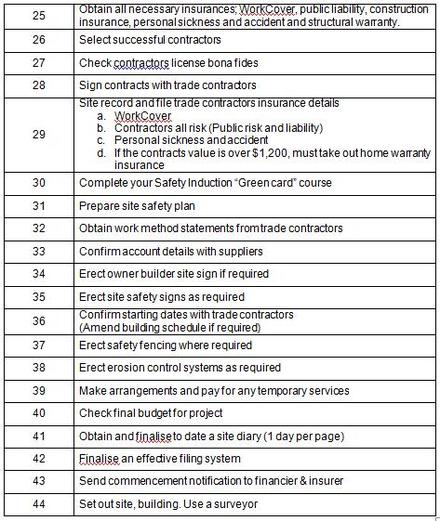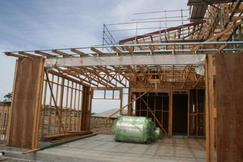1.0 RESPONSIBILITIES OF AN OWNER BUILDER
When you first decide to undertake a project as an owner-builder, you will need to gather a considerable amount of information.
In real terms your responsibility as an owner-builder can be broken down into three distinct areas.
taxation, insurances, site safety etc.
Your responsibility to yourself
This may appear obvious, but it is worth mentioning anyway:
Having said this, if you remain organised and focused, commit the time and effort, the rewards can be great and the satisfaction immeasurable.
Your Responsibility to the Workers on Your Site
As an Owner-Builder, you are the Principal Contractor, Primary Contractor or responsible builder or may be considered the Person Conducting and Business Undertaking (PCBU).
Along with these lofty titles comes some reasonably onerous obligations.
You are solely and totally responsible for providing and ensuring a safe and healthy working environment.
You must ensure the requirements of the relevant Occupational and Workplace Health and Safety legislation are complied with.
The text of the study guide is designed to give individuals an understanding of and an insight into the types of hazards which are likely to be found on a construction site.
YOU MUST ENSURE THE REQUIREMENTS OF THE RELEVANT OCCUPATIONAL HEALTH AND SAFETY ACT ARE COMPLIED WITH IN RESPECT ALL ACTIVITIES ON YOUR SITE.
BECAUSE OF THESE OBLIGATIONS, IT IS OUR BELIEF, YOU MUST OBTAIN YOUR WHITE CARD. The White Card is not required to obtain a permit from the QBCC.
These sites provide access to the Acts, Regulations and Codes of Conduct for construction work within Queensland.
The two diagrams which follow, will assist you in planning your project and recognising areas of responsibility you will need to be aware of throughout the project.
These are identified as;
Let’s now look at the specific responsibilities of an owner- builder.
These will all be discussed in detail in the following sections of this text.
- Your responsibility to yourself
- Your responsibility to the workers on your site
- Your responsibility to the community
taxation, insurances, site safety etc.
Your responsibility to yourself
This may appear obvious, but it is worth mentioning anyway:
- You have a responsibility to yourself and your family or partners to ensure that your hard earned dollars are used in the most effective way possible; and
- It is necessary to ensure your lifestyle, both personal and professional are not adversely affected through the performance of your functions as an Owner-Builder.
Having said this, if you remain organised and focused, commit the time and effort, the rewards can be great and the satisfaction immeasurable.
Your Responsibility to the Workers on Your Site
As an Owner-Builder, you are the Principal Contractor, Primary Contractor or responsible builder or may be considered the Person Conducting and Business Undertaking (PCBU).
Along with these lofty titles comes some reasonably onerous obligations.
You are solely and totally responsible for providing and ensuring a safe and healthy working environment.
You must ensure the requirements of the relevant Occupational and Workplace Health and Safety legislation are complied with.
The text of the study guide is designed to give individuals an understanding of and an insight into the types of hazards which are likely to be found on a construction site.
YOU MUST ENSURE THE REQUIREMENTS OF THE RELEVANT OCCUPATIONAL HEALTH AND SAFETY ACT ARE COMPLIED WITH IN RESPECT ALL ACTIVITIES ON YOUR SITE.
BECAUSE OF THESE OBLIGATIONS, IT IS OUR BELIEF, YOU MUST OBTAIN YOUR WHITE CARD. The White Card is not required to obtain a permit from the QBCC.
These sites provide access to the Acts, Regulations and Codes of Conduct for construction work within Queensland.
The two diagrams which follow, will assist you in planning your project and recognising areas of responsibility you will need to be aware of throughout the project.
These are identified as;
- Figure: 1.4.3(1) Planning Flow Chart and Responsibilities
- Figure: 1.4.3(2) Preliminary Checklist
Let’s now look at the specific responsibilities of an owner- builder.
- Overseeing and supervising all tradespeople
- Ordering and delivering of all materials, and the management of the building site
- Obtaining all necessary Council and Authority approvals for the work
- Ensuring that the financial, taxation and insurance requirements of the building works are met, and fully compliant with all laws
- Providing a safe working environment
- Ensuring any contractor engaged is appropriately licensed to do the work contracted for.
These will all be discussed in detail in the following sections of this text.
Figure 1.4.3(1) Key Responsibilities of an Owner Builder
Figure 1.4.3(1)
1.1 OVERSEEING AND SUPERVISING ALL TRADES PEOPLE
Initially, it will be necessary for you to select your trades people and suppliers.
To get a start, it is best to call on personal friends and contacts who either have the required skills and or qualifications or talk to people who have recently completed renovations or construction projects of their own.
Other methods of finding appropriate trades people or suppliers are:
- Google Search
- Local Newspaper Classifieds
- Professional Associations
- Referrals
- Advertising, Sites Signs etc.
The amount of involvement you have and the time taken will make the difference between a successful project which runs on time and on budget and one which has costly overruns in both these critical areas.
Sound, accurate documentation and good interpersonal skills on site are essential in keeping the project 'on track'.
As the Owner-Builder you will need to visit the site regularly to inspect the quality and progress of works relative to the established schedule.
You will need to coordinate and manage the project to ensure all works are completed to a satisfactory standard, and as necessary engage appropriately qualified consultants to 'sign off' on the works.
Remember certain stages of the work or specific structural elements will require inspection and certification.
It is important to ensure these inspections are included in the works schedule and conducted in a timely manner to minimise any delays to the works
1.2 ORDERING & DELIVERING OF MATERIALS
Section 4.15 and 4.16 plus the 4.14 (Heath and Safety) discuss ordering, payment, processing, handling and storage of materials on site.
1.3 OBTAINING ALL NECESSARY APPROVALS
Refer to Section 5 page 66 of the QBCC Study Guide and the section on private certifiers in this manual.
What works can Owner Builders carry out?
|
Domestic building works are the only type of works permitted under an owner-builder permit.
You cannot carry out works on a multiple dwelling or on any building intended for commercial or industrial use. You can however carry out works on an existing unit, these works are limited to, repair, renovation, alteration, extension or improvement. |
Works I can conduct myself?
|
You cannot personally carry out any building works which involve, plumbing, drainage, gasfitting, electrical, termite management or waterproofing, asbestos removal or scaffolding unless you hold the appropriate occupational or trade contractors license.
These works must be carried out and certified by appropriately licensed trade contractors. Additionally, the QBSA provides details on certain limitations that affect the issue of an owner-builder permit. |
How often can I get an Owner Builders Permit?
You cannot obtain another permit within six years from the date of issue of a previous permit unless the QBCC is satisfied there are special circumstances, and an exemption has been approved. (see above)
How do I get a permit?
One of the applicants named on the Title must complete an Owner Builder Course prior to lodging your application (or be granted an exemption from completing the course) - click here for more information
Complete an Owner Builder Permit Application form.
Lodge the application form along with proof of ownership of the property (Certificate of Title) from the Titles Office , proof of identity and the required fee (all information is contained in the application form)
If you are a lessee of the land you will need to seek legal advice regarding your rights and obligations. You will need to provide (in addition to the information noted above excluding the proof of ownership):
- Proof of the lessor's ownership of the property
- A copy of the lease agreement
- A letter from the owner/lessor giving you permission to perform the work under an owner builder permit on the property
Can a company apply for an Owner Builders Permit?
Yes - Where a company is making application for a permit the following applies:
- The application should be made by the company and MUST contain all director's names and signatures
- One of the directors must complete the Owner Builder Course or be granted an exemption from having to undertake the course
- Proof of the company's directors must be provided in the form of an Australian Securities and Investment Commission Current Company Extract or an Historical Company Extract.
Description of Work and Value
It is important that you provide an detailed description of the works to be undertaken and an accurate estimated value of the cost of construction. A permit may be rejected or cancelled where the value of work undertake is in excess of the permitted amount.
How long does the application process take?
QBCC aims to process an application within one month of receipt if all required information is provided and there are no requests for exemptions. Exemption or special circumstance requests or missing documentation will delay the process.
Once processed the permit will be sent to your notified postal address.
Notification of Title
When you are issued with a permit a notification is entered onto the title for a minimum of seven years. This notification indicates that an owner builder permit has been granted in relation to domestic building work carried out on the property. The purpose of the notification is to ensure that any future purchasers are made aware that the work was performed under a permit. It may be removed by the Titles Queensland after seven years from the date of entry has elapsed. This is detailed more fully in your permit, in some instances it can affect the sale of your property. Contact Titles Queensland to obtain a copy of your Title.
Note - you are only entitled to one permit every six years!
Are there any exceptions from this 6 year rule?
In exceptional circumstances, QBCC may be able to grant a second permit within a six year timeframe. Exceptional circumstances could be if either you, or a person you are living with, is suffering from a serious medical condition or severe financial hardship and the work to be carried out would help.
If you are applying for another building permit within six years of obtaining the first permit you are required to apply for exemption from the six-year ruling. You will need to complete and lodge an Application for Exemption from the Six-year Ruling form.
1.4 APPLICATION FOR AN OWNER BUILDERS PERMIT
Under the Queensland Building and Construction Commission Act 1991 you are required to obtain an owner builder permit if you wish to perform building work to a value of $11,000 or more on your own property. QBCC is required to keep a register of all owner builder permit holders. The register is in the form of an on-line search facility and is available for inspection by any person.
HOW DO I OBTAIN AN OWNER BUILDERS PERMIT?
To apply for an owner builder permit you must provide the following:-
- A completed application form signed by all owners or company directors;
- Payment of the application fee;
- An original or certified copy of a Current Title Search or Registration Confirmation Statement no older than 30 days.;
- Proof of Identity;
- Proof of a completed Owner Builder Course.
DETERMINING THE VALUE OF OWNER BUILDER WORK
The value of building work must be determined by calculating the cost of all materials and the cost a licensed contractor would charge you for the work as if they were performing the work including GST.
If you discover during the construction process the value of work needs to be increased, simply complete the Application to Amend an Existing Owner Builder Permit form available at QBCC website from www.qbcc.qld.gov.au. Amendments to an existing permit can only be made within 6 months from the date of issue of the permit.
CONDITIONS OF THE PERMIT
Domestic building work is the only type of work you may perform under an owner builder permit.
You cannot carry out building work for a multiple dwelling or for a building intended to be used for commercial purposes. However a permit may be issued for the renovation, alteration, extension, improvement or repair of an EXISTING unit.
You can only personally carry out building work which requires a fire protection licence where the value of the work is less than $1,100.00 (including labour and materials). Where the value of work is $1,100.00 or over, the work must be carried out by a licensed contractor.
You cannot personally carry out any building work which involves Plumbing, Draining, Gas Fitting or Termite Management work unless you hold the appropriate occupational licence. If you do not hold the appropriate licence the work must be carried out by a licensed contractor. You can be fined if you perform this work yourself.
You may only carry out the building work as stated in the permit.
If you engage anyone to carry out building work, the person/s must hold the relevant QBCC contractor’s licence.
You are a person listed on the property title; a company director if the property is owned by a company; or a lessee if the property is under a lease agreement.
APPROVAL PROCESS
Approval of the building documents (plans, specification etc) must be obtained from a private building certifier or local government (council) before any building work is commenced (this includes any earthworks). Approval is also required at the completion stage of construction. The certifier is prevented from giving an approval until after receipt of the QBCC owner builder permit.
It is the responsibility of the owner builder to build in accordance with the approved documents. If it is necessary to change the design, the owner builder must consult with the certifier to ascertain if amended documents are required before any change is made to the construction.






